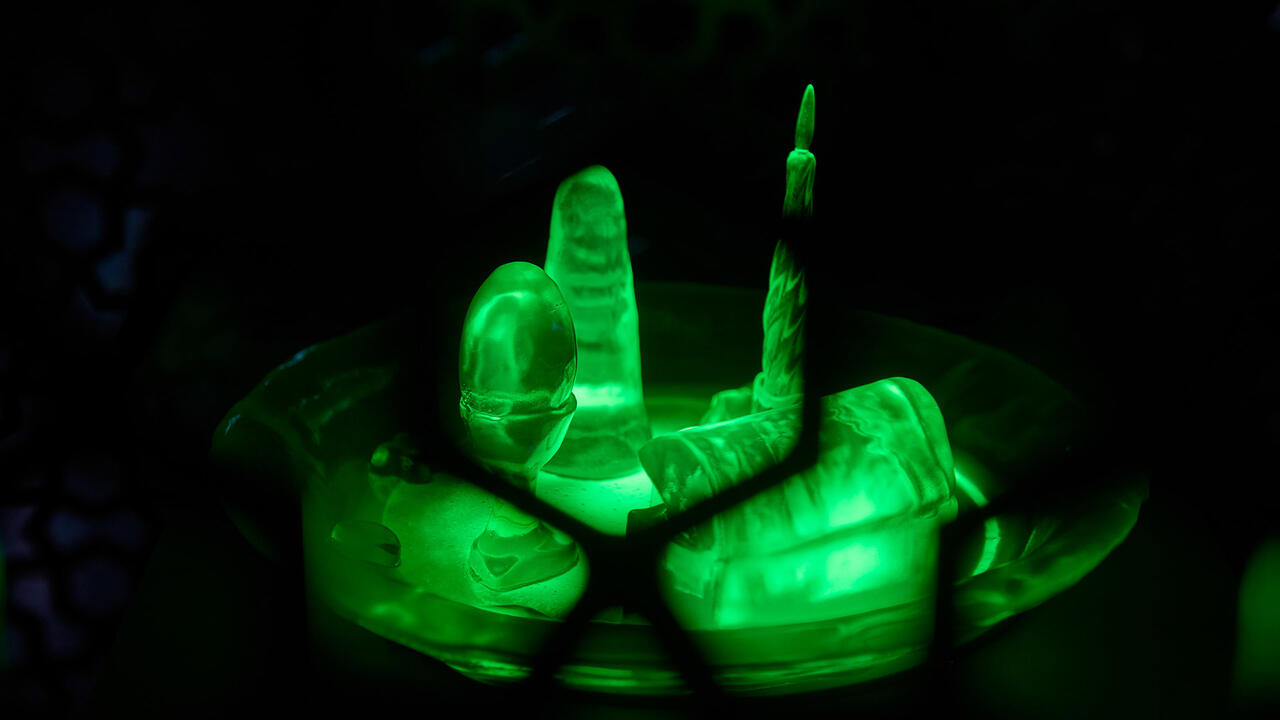The Self-Concealing Craft of Kristin Walsh
In the artist’s debut show with Petzel Gallery, New York, eight gleaming, machinic sculptures upend expectations with flickers of strangeness
In the artist’s debut show with Petzel Gallery, New York, eight gleaming, machinic sculptures upend expectations with flickers of strangeness

As we hurtle towards a confrontation with the awesomeness of algorithmic intelligence, there is something particularly poignant about the sadness and simplicity of primitive machinery. All that pre-digital friction. Pipes and chutes and arm-sized bolts. All that mere matter. Many of the works in Kristin Walsh’s show, ‘The working end’, at Petzel Gallery, resemble mechanical components stripped from their functional assemblies. Their consequent dysfunction has not proven unproductive, though; inscrutably yet insistently, they have begun to dream.

Aluminium features prominently in the show’s eight sculptures, parts and wholes of which could pass as readymades. But far from it: Walsh produces her work largely by sheet forming, an especially arduous approach to sculpting. Her craft is the self-concealing kind. The surfaces tend toward factory-issued refinement – inexpressively polished or bead blasted to an even, satin sheen. Sited in a white-walled gallery on an ebony-hued floor, they exude an austere, rigorous formality. Two of the largest constructions, Engine no. 12 (2024) and Indicator no. 5 (2024), dominate the rooms they occupy with intimidating coldness. Around them, smaller sculptures punctuate the interstitial areas. One of these, Engine no. 13 (2024), hangs on a side wall like a taxidermized tractor, its trophy pistons gleaming in a neat arrangement.
Indicator no. 5 looks like an upturned metal piano merged with a subway turnstile. From its bulky form a slender metal tube ascends, penetrating the gallery ceiling and insinuating itself into the building’s invisible systems. On the ground, where one of the turnstile's appendages points, sits a die. If you notice this stray bit of unassuming world, oddly juxtaposed with the formalist construction that looms above it, you may also observe it quiver, levitate, spin and then settle into stillness once again. This sorcery is controlled by a cleverly concealed system of electrically activated magnetism. A viewer’s anticipation has time to ripen into anxiety, as periods of stillness stretch out past the borders of internet-era patience. Each time the activation occurs, it is a freakish aberration. You want to turn to someone beside you: Did you see that? I swear it just…

Besides machine aesthetics, the exhibition references the typologies of public transportation. Lining a back wall is a trio of handgrips styled after elements of New York City’s MTA subway. Two of them break form by wrapping themselves in sinuous knots. They could be read as simple sculptural exercises in substituting transformation for standardization. Or they could be conceptually connected to the ways that we humans are enmeshed in mechanical systems – subject to timetables that often seem to serve the quixotic whims of indifferent machinery as much as our human needs. See for example: the MTA. The timekeeping aspect of Walsh’s mechanisms is further emphasized by Indicator no. 1 (2022), an upside-down public transit light that rotates with segmented periodization, like the dial of a clock. And yet, since its spherical head is uniform on all sides, it does not record the time it marks – if it is a clock, it lacks a face.

The smallest work in the show is a tightly contained statement. Engine no. 11 (2024) sits on the ground, looking like half a polished engine casing. On its surface, scattered matchsticks lie on their sides. The ‘engine’ issues a bassy thump; a force is engaged; and the matches wriggle and squirm upright, their phosphorus ends pointed aloft. They do a brief, shimmying dance and then fall flat once again. Eerie and wondrous, Engine no. 11 dramatizes a world where improbabilities simmer at the edges of one’s vision, where static expectations are unbalanced by flickers of unexplainable strangeness.
‘Kristin Walsh: The working end’ is on view at Petzel Gallery, New York until 19 October
Main image: ‘Kristin Walsh: The working end’, 2024, exhibition view. Courtesy: the artist and Petzel, New York; photograph: Sebastian Bach





















